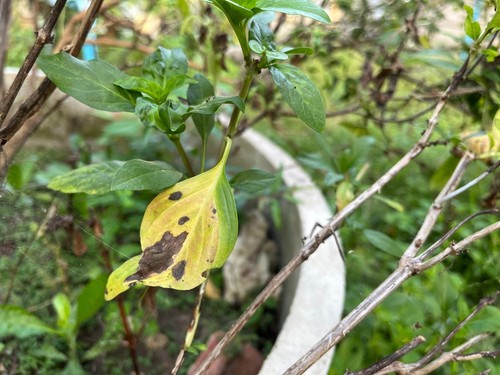Basil is a popular herb used in various culinary dishes around the world. However, brown spots on basil leaves can be a common issue that basil growers face. These spots can be unsightly and may indicate a problem with the plant’s health.
Identifying the cause of basil brown spots on leaves is the first step to resolving the issue. There are various reasons why brown spots may appear on basil leaves, including fungal or bacterial infections, pest damage, sunburn, nutrient deficiencies, and overwatering. It is important to correctly diagnose the cause of the brown spots to effectively treat the issue.
Preventing and treating brown spots on basil leaves involves proper plant care and management. This includes maintaining a healthy growing environment, practicing safe practices with infected plants, and ensuring proper nutrient management.
By following these steps, basil growers can help maintain healthy basil plants and prevent the occurrence of brown spots on their leaves.
Key Takeaways
- Identifying the cause of brown spots on basil leaves is crucial to effectively treating the issue.
- Proper plant care and management can prevent the occurrence of brown spots on basil leaves.
- Nutrient management is an important aspect of maintaining healthy basil plants.
Also see:
- Azalea Yellow Leaves Brown Spots
- Avocado Plant Brown Spots on Leaves
- Blueberry Leaves Turning Yellow with Brown Spots
Identifying Basil Brown Spots on Leaves
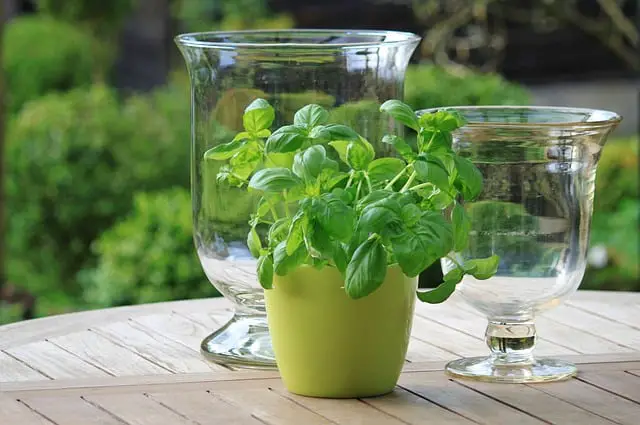
Basil is a popular herb that is easy to grow both indoors and outdoors. However, brown spots on basil leaves can be a common problem that many gardeners face. Identifying these brown spots early on is crucial to prevent further damage to the plant and ensure healthy growth.
Brown spots on basil leaves can be localized or spread throughout the entire plant. These spots can vary in size and color, ranging from light brown to dark brown or black. In some cases, the spots may appear as small dots, while in other cases, they may appear as larger irregular-shaped patches.
There are several possible causes of brown spots on basil leaves, including fungal or bacterial infections, pest damage, nutrient deficiencies, sunburn, and temperature swings. It is important to identify the cause of the brown spots to determine the appropriate treatment.
One way to identify the cause of the brown spots is to observe the location of the spots on the plant. For example, if the brown spots are localized on the lower leaves, it may be a sign of fungal infection such as downy mildew. On the other hand, if the brown spots are spread throughout the entire plant, it may be a sign of a nutrient deficiency or pest damage.
Another way to identify the cause of brown spots is to look for other symptoms on the plant. For example, if the plant is wilting or the leaves are curling, it may be a sign of a fungal infection or nutrient deficiency. If the plant has holes in the leaves, it may be a sign of pest damage.
Basil Leaves Developing Brown Spots – 3 Common Problems
Basil is a popular herb that is used in many dishes around the world. However, brown spots on basil leaves can be a sign of various issues that can affect the health of the plant. In this section, we will discuss some of the common causes of brown spots on basil leaves.
Diseases and Fungal Infections
One of the most common causes of brown spots on basil leaves is fungal infections. Fusarium wilt, downy mildew, and fungal leaf spot are some of the common fungal diseases that can affect basil.
These diseases are caused by different types of fungi that can infect the plant through the soil, water, or air. Fungal infections can cause brown spots on the leaves, as well as other symptoms such as yellowing, wilting, and stunted growth.
Bacterial leaf spot, caused by the bacterium Pseudomonas cichorii, is another disease that can cause brown spots on basil leaves. This disease can spread rapidly and cause severe damage to the plant if left untreated.
Pests and Insects
Pests and insects can also cause brown spots on basil leaves. Aphids, spider mites, and whiteflies are some of the common pests that can infest basil plants. These pests can feed on the leaves, causing damage that can lead to brown spots. Caterpillars and other leaf-eating insects can also cause similar damage to basil leaves.
Environmental Factors
Environmental factors such as temperature fluctuations, sunburn, and nutrient deficiencies can also cause brown spots on basil leaves. Basil plants require a warm and sunny environment to grow, and exposure to extreme temperatures can cause stress that can lead to brown spots.
Nutrient deficiencies, especially in nitrogen and magnesium, can also cause brown spots on the leaves.
Effects of Brown Spots on Basil
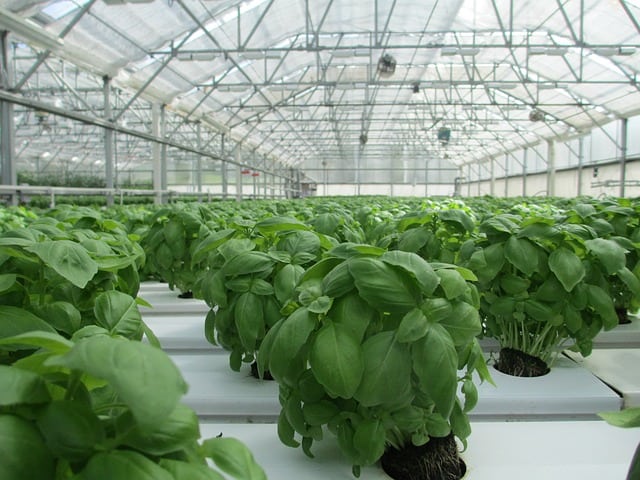
Brown spots on basil leaves can have a significant impact on the plant’s growth and flavor. Here are some of the effects of brown spots on basil:
Impact on Plant Growth
When basil leaves develop brown spots, it can stunt the plant’s growth. The brown spots can be a sign of a fungal or bacterial infection, which can spread and damage the plant’s leaves, stems, and roots. The infection can also reduce the plant’s ability to absorb nutrients from the soil, which can further slow its growth.
If left untreated, the brown spots can cause the plant to become stunted, meaning it will not grow to its full potential. This can result in a smaller yield of basil leaves, which can be frustrating for gardeners who are looking to harvest a large amount of basil.
Impact on Flavor
Brown spots on basil leaves can also have an impact on the plant’s flavor. If the brown spots are caused by a fungal or bacterial infection, it can make the basil taste bitter or unpleasant. This can be especially noticeable if the infected leaves are used in cooking or to make pesto.
In addition to affecting the flavor of the basil, brown spots can also make it less visually appealing. This can make it harder to sell or use in recipes where the appearance of the basil is important.
To prevent the negative effects of brown spots on basil, it is important to identify the cause of the brown spots and take appropriate action. This may include treating the plant with a fungicide or adjusting the soil’s nutrient levels. With proper care, basil plants can grow healthy and produce a bountiful harvest of flavorful leaves.
Preventing and Treating Brown Spots
Proper care and maintenance of basil plants can prevent and treat brown spots on basil leaves. Here are some tips to follow:
1. Proper Watering
Overwatering and underwatering can both lead to brown spots on basil leaves. It is important to water the basil plant properly. Water the plant at the soil level instead of overhead watering.
Overhead watering can cause water beads to form on the leaves, which can lead to sunburn and fungal infections. Water the plant when the soil feels dry to the touch. Avoid letting the soil dry out completely.
2. Adequate Sunlight and Air Circulation
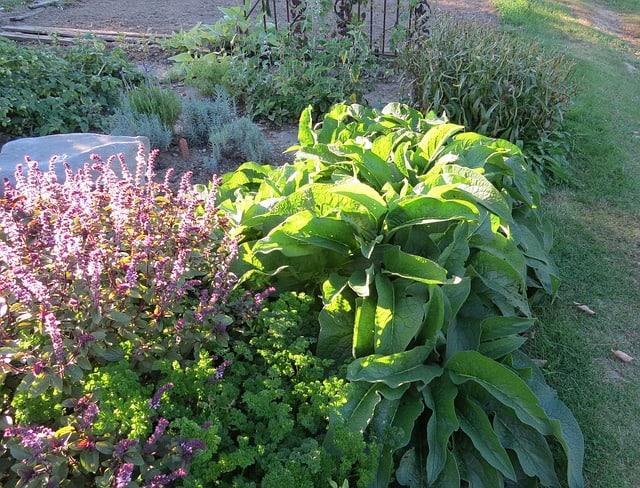
Basil plants require adequate sunlight and air circulation to prevent brown spots on the leaves. Place the plant in a location that gets at least six hours of sunlight a day. Make sure the plant is not crowded with other plants and has enough space to grow.
Good air circulation helps prevent fungal infections and other diseases. Avoid placing the plant in a humid location.
3. Use of Organic Fungicides and Pesticides
Organic fungicides and pesticides can help prevent and treat brown spots on basil leaves. Neem oil is a natural fungicide and pesticide that can be used to control fungal infections and pests.
Spray the plant with neem oil every two weeks to prevent and control brown spots. Copper soap or dishwashing detergent can also be used to clean the leaves and prevent bacterial growth.
Nutrient Management for Healthy Basil
Understanding Nutrient Deficiencies
Basil needs a range of nutrients to grow healthy and produce flavorful leaves. Nitrogen, magnesium, and potassium are the most important nutrients for basil to thrive. Inadequate levels of these nutrients can cause nutrient deficiencies, which can lead to brown spots on basil leaves.
Nutrient deficiencies can also cause stunted growth, yellowing of leaves, and poor overall plant health.
One of the most common nutrient deficiencies in basil is nitrogen deficiency. Nitrogen is a crucial nutrient for plant growth and is responsible for the green color of leaves.
If your basil plant has yellowing leaves or stunted growth, it may be suffering from nitrogen deficiency. Magnesium and potassium deficiencies can also cause yellowing of leaves and brown spots on basil leaves.
Fertilizing Your Basil
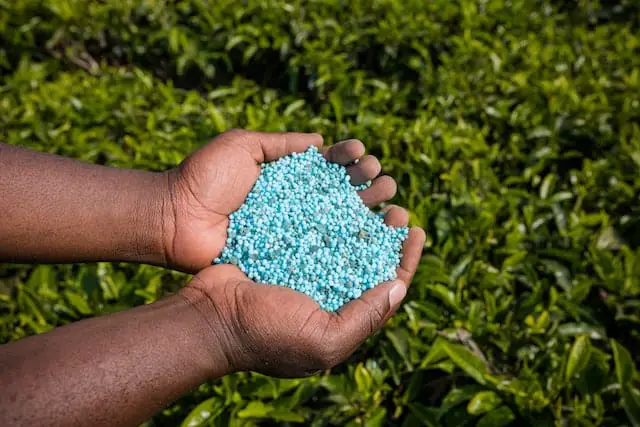
Fertilizing your basil is an effective way to prevent nutrient deficiencies and promote healthy growth. You can use a range of fertilizers, including compost, manure, and commercial fertilizers. When using commercial fertilizers, choose one that is specifically formulated for herbs and vegetables.
To fertilize your basil, apply the fertilizer to the soil around the plant’s base. Avoid getting the fertilizer on the leaves, as this can cause leaf burn. Water the plant thoroughly after fertilizing to help the nutrients reach the roots.
It’s important to note that over-fertilizing your basil can be just as harmful as under-fertilizing it. Over-fertilization can lead to nutrient burn, which can cause brown spots on basil leaves and other symptoms of nutrient toxicity.
To avoid over-fertilization, follow the manufacturer’s instructions on the fertilizer package and avoid applying more than the recommended amount.
In addition to fertilizing, proper drainage is also important for healthy basil growth. Basil thrives in well-draining soil, so make sure the soil has good drainage. If the soil is too compacted, consider adding organic matter, such as compost, to improve drainage.
Safe Practices with Infected Basil Plants
Is It Safe to Eat?
When basil plants are infected with brown spots, it is important to take necessary precautions to avoid consuming contaminated leaves. While some infections may not be harmful to humans, others can be toxic and cause illness. It is best to err on the side of caution and avoid consuming any basil leaves that are discolored or show signs of disease.
Handling and Disposal of Infected Plants
If you have an infected basil plant, it is important to handle it with care to avoid spreading the disease to other plants or surfaces. Wear gloves when handling infected plants and wash your hands thoroughly after handling them.
To dispose of an infected plant, it is best to remove it entirely from your garden or indoor growing space. Do not compost infected plants, as this can spread the disease to other plants in your compost pile. Instead, dispose of infected plants in a sealed plastic bag and throw them away in the trash.
It is also important to sanitize any tools or surfaces that have come into contact with infected plants. Use a solution of one part bleach to nine parts water to disinfect tools and surfaces, and allow them to air dry before using them again.
By following these safe practices, you can help prevent the spread of disease and ensure that your basil plants remain healthy and safe to consume.
Maintaining a Healthy Basil Garden
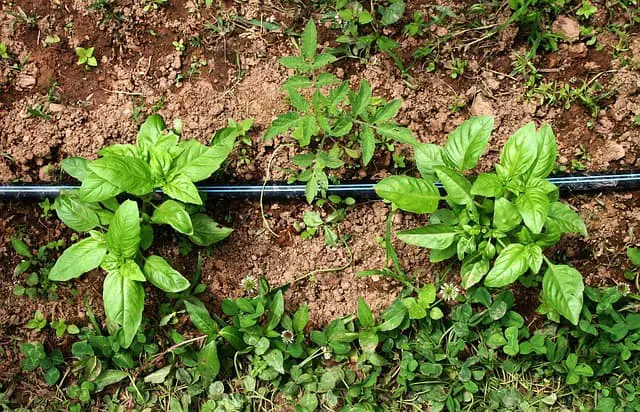
Basil is a popular herb among gardeners because of its versatility in the kitchen and ease of care. However, basil plants are prone to developing brown spots on their leaves, which can be a sign of various issues such as pathogen infection, pest damage, or even improper handling during harvest.
In this section, we will discuss how to maintain a healthy basil garden by choosing the right basil varieties, proper plant spacing, and pruning.
1. Choosing the Right Basil Varieties
When selecting basil plants, it is essential to choose the right variety for your garden. Sweet basil is the most common type of basil, and it’s a great choice for beginners. Other sweet basil varieties include Genovese, Italian Large Leaf, and Lettuce Leaf. These varieties are perfect for making pesto, salads, and other culinary delights.
2. Proper Plant Spacing and Pruning
To maintain a healthy basil garden, it is crucial to provide adequate plant spacing and pruning. Basil plants need enough space to grow, and planting them too close together can lead to poor air circulation, which can cause fungal infections and other issues. For best results, plant basil at least 12 inches apart in rows or clusters.
Pruning is also an essential part of maintaining a healthy basil garden. Regular pruning encourages bushy growth and prevents the plant from becoming too leggy. It also helps to remove diseased or damaged leaves and prevents the spread of pathogens.
3. Care Regimen and Observation
To keep your basil plants healthy, it is important to follow a regular care regimen. This includes watering, fertilizing, and pest control. Basil plants prefer well-draining soil and require adequate sunlight to thrive. Water the plants regularly, but be careful not to overwater them, as this can lead to root rot.
Observation is also crucial when it comes to maintaining a healthy basil garden. Keep an eye out for signs of pest damage, such as holes in the leaves or sap on the plant. Slugs are a common pest that can damage basil plants, so be sure to check for them regularly.
Frequently Asked Questions
How can I treat brown spots on my basil leaves?
There are several ways to treat brown spots on basil leaves, depending on the cause. If the spots are caused by a fungal infection, removing infected leaves and applying a fungicide can be effective.
If the spots are caused by bacterial leaf spot, removing infected leaves and applying a copper-based fungicide can help. In some cases, improving air circulation and reducing humidity can also help prevent further spread of the infection.
What causes brown spots to appear on basil leaves?
Brown spots on basil leaves can be caused by a variety of factors, including fungal or bacterial infections, pests, nutrient deficiencies, and environmental stressors such as excessive heat or humidity. Identifying the cause of the spots is important in order to determine the best course of treatment.
Is it safe to use brown basil leaves in pesto?
While brown spots on basil leaves are unappealing, they do not necessarily indicate that the leaves are unsafe to eat. However, it is important to thoroughly wash and inspect the leaves before using them in recipes. If the leaves are heavily damaged or show signs of mold or other growths, it is best to discard them.
What is the best way to prevent bacterial leaf spot on basil?
Preventing bacterial leaf spot on basil involves several measures, including using disease-free seeds or plants, avoiding overhead watering, and providing good air circulation and drainage. It is also important to avoid handling plants when they are wet, as this can spread the bacteria.
How do I know if my basil is diseased?
Signs of basil disease can include wilting, yellowing or browning of leaves, stunted growth, and the presence of spots or discoloration on leaves or stems. It is important to monitor plants regularly and take action at the first sign of disease to prevent further spread.
What are some effective treatments for basil fungus?
Effective treatments for basil fungus can include removing infected leaves, improving air circulation and reducing humidity, and applying a fungicide. It is important to identify the specific type of fungus causing the problem in order to choose the most effective treatment.

Hey, I’m Lisa and I’ve been an avid gardener for over 30 years. I love writing, talking and living in the garden! Feel free to connect with me on my socials below

